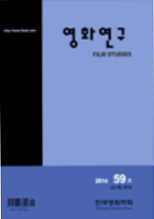- 영문명
- Institutionalization Process of Culture Films: Focused on change of film law and policy in 1960s - 70s
- 발행기관
- 한국영화학회
- 저자명
- 조준형
- 간행물 정보
- 『영화연구』제59호, 365~399쪽, 전체 35쪽
- 주제분류
- 예술체육 > 예술일반
- 파일형태
- 발행일자
- 2014.03.31
7,000원
구매일시로부터 72시간 이내에 다운로드 가능합니다.
이 학술논문 정보는 (주)교보문고와 각 발행기관 사이에 저작물 이용 계약이 체결된 것으로, 교보문고를 통해 제공되고 있습니다.

국문 초록
영문 초록
This article is to describe the institutionalization process of culturefilms based on the changes of film law in 1960s-70s. It is of a relativelyrecent trend to study non-fiction films, which is often represented asculture films, and to value them as important historical materials. So far,most articles have cited individual culture films or a group of culturefilms to describe the purpose of government policy or the map of ideology. However, those articles hardly provide answers to the question ‘What isa culture film?’ This is because the term ‘culture film’ covers films invarious categories and the term itself was invented for the sake of makingpolicies. Thus, this article focuses on the fact that the ambiguous andcollective concept ‘culture film’, which should have been divided intovarious categories such as documentary, enlightenment film, propagandafilm, education film, animation, etc., was able to survive until late 1990from Japanese colonial era due to institutional framework that was a partof the government policy. Therefore, the primary purpose of this article is to provide a base lineto understand the concept of culture film by examining how the culturefilm was defined, particularly based on the laws and policies in the1960s-70s. In addition, in order to understand that the concept of culture film was the result of continuous reconstruction, and not just a productsolely regulated according to the intentions of policy makers, severalexamples are presented that show those laws were also changed bymarket participators’ actions utilizing the niches between the laws. Thisarticle provides several implications for identifying the dynamics betweennot only government administration and films, but also governmentadministration and market, as well as for understanding the concept ofculture film in the era of Park Jung-hee regime.
목차
1. 들어가며
2. 전사: 영화법 이전 문화영화 관련 규정 검토
3. 제도화와 혼란: 영화법 제정 이후 문화영화 정책 변화
4. 나오며
키워드
해당간행물 수록 논문
- SF 영화의 다문화(주의)적 시선
- 전후(戰後)의 한⋅중⋅일 멜로드라마 비교연구
- 영화음악 공연사용료 소송을 통해서 본 영화의 저작권법적 쟁점
- 문화영화의 제도화 과정
- 1960년대 쿠바영화에서의 혁명수용 형태 연구
- 한국 실험영화 감독들의 장르정체성과 해외경험에 따른 미학적, 제도적 인식의 차이
- 식민지 조선의 발성영화 상영에 대한 역사적 연구
- 경성고등연예관 연구
- 오디션 연기의 미학과 방법론 연구
- 소설 <재능 있는 리플리 The Talented Mr. Ripley>와 각색영화 비교 연구
- ‘새로운 영화 읽기의 제안’ 혹은비판적 시네필리아의 형성
- 영화연구 제59호 목차
- 트랜스-로컬에 관한 이론과 영화적 적용
- <8½>의 내러티브 구조 재해석
- 한국영화학회 이사회 (2013-2014)
- <디 아워스>의 오프닝 시퀀스 연구
참고문헌
관련논문
예술체육 > 예술일반분야 BEST
- 생성형 AI 도구와 디자이너의 협업 프로세스 개발 - 이미지를 통한 아이디어 확산에서 고해상도 렌더링까지
- 영화 [올드보이]와 소포클레스 「오이디푸스 왕」의 상동성 연구
- 커피 프랜차이즈 기업의 캐릭터 콜라보레이션 전략 연구 - 큐렌들리 마케팅을 중심으로
최근 이용한 논문
교보eBook 첫 방문을 환영 합니다!

신규가입 혜택 지급이 완료 되었습니다.
바로 사용 가능한 교보e캐시 1,000원 (유효기간 7일)
지금 바로 교보eBook의 다양한 콘텐츠를 이용해 보세요!



